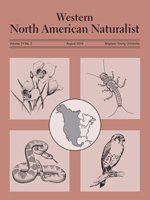We documented the effect of drought-induced mortality of pinyon pine (Pinus edulis Engelm.) on communities of ground-dwelling arthropods. Tree mortality alters microhabitats utilized by ground-dwelling arthropods by increasing solar radiation, dead woody debris, and understory vegetation. Our major objectives were to determine (1) whether there were changes in community composition, species richness, and abundance of ground-dwelling arthropods associated with pinyon mortality and (2) whether specific habitat characteristics and microhabitats accounted for these changes. We predicted shifts in community composition and increases in arthropod diversity and abundance due to the presumed increased complexity of microhabitats from both standing dead and fallen dead trees. We found significant differences in arthropod community composition between high and low pinyon mortality environments, despite no differences in arthropod abundance or richness. Overall, 22% (51 taxa) of the arthropod community were identified as being indicators of either high or low mortality. Our study corroborates other research indicating that arthropods are responsive to even moderate disturbance events leading to changes in the environment. These arthropod responses can be explained in part due to the increase in woody debris and reduced canopy cover created by tree mortality.
How to translate text using browser tools
1 August 2014
Pinyon Pine Mortality Alters Communities of Ground-Dwelling Arthropods
Robert J. Delph,
Michael J. Clifford,
Neil S. Cobb,
Paulette L. Ford,
Sandra L. Brantley
ACCESS THE FULL ARTICLE





